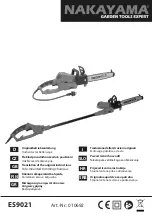
12
English
bound to the material, possibly resulting in overload and burn-out of
the motor.
BLADE DESCRIPTION
Type of band saw blade
Bi-Metal
Number of teeth
24
18
14
14/18
Workpiece thickness
1/8" (3.2 mm) and under
•
•
1/8"–1/4" (3.2 mm–6.4 mm)
•
•
Blade Speed
Your DCS374 portable band saw is equipped with variable speed for
greater versatility. Turn the speed wheel (K) to select the desired speed
(Fig. 2). Speed 1 is the slowest speed; Speed 5 is the fastest. Use
speed settings 1–5.
When cutting copper, brass, bronze, aluminum, cast iron, angle iron,
and mild steel, use a higher speed.
When cutting plastic pipe, tougher steels, chrome steel, tungsten
steel, stainless steel, and other problem materials, use low speed.
NOTE:
When cutting plastic pipe, higher speeds may melt plastic.
Blade Tracking (Fig. 2)
WARNING: To reduce the risk of serious personal injury,
turn tool off and remove the battery pack before making any
adjustments or removing/installing attachments or accessories.
An accidental start-up can cause injury.
Your band saw is equipped with an adjustable blade tracking
mechanism which assures proper blade tracking at all times. The back
edge of a properly aligned blade will run lightly against one or both of
the back up rollers in the blade guides. (The pressure between the
edge of the blade and the roller will be very slight and will not damage
either the blade or the roller.)
TO ADJUST THE BLADE TRACKING
1. Use a 1/2" (13 mm) wrench to loosen the adjustment locking
nut (G), shown in Figure 2 by turning it one or two turns
counterclockwise.
2. Use a screwdriver to turn the adjustment screw (H) 1/4 turn.
Turning the screw clockwise will move the blade up toward the
blade guide rollers. Turning the screw counterclockwise will move
the blade down away from the rollers.
3. Adjust so that the back edge of the blade lightly touches the
rollers then securely tighten the adjustment locking nut. (It will be
necessary to insert the battery pack and run the saw to observe
the tracking.)
4. Observe blade tracking between runs and repeat Steps 1–4 as
necessary to achieve proper blade tracking.
WARNING:
Make sure the battery is removed if further tracking
adjustment is needed.
ASSEMBLY AND ADJUSTMENTS
WARNING: To reduce the risk of serious personal injury,
turn tool off and remove the battery pack before making any
adjustments or removing/installing attachments or accessories.
An accidental start-up can cause injury.
Installing and Removing the Battery Pack
(Fig. 1, 2, 5)
NOTE:
For best results, make sure your battery pack is fully charged.
To install the battery pack (R) into the tool handle, first position the bail
handle fully forward, then align the battery pack with the rails inside the
tool’s handle and slide it into the handle until the battery pack is firmly
seated in the tool and ensure that it does not disengage.
To remove the battery pack (R) from the tool, press the release button
(S) and firmly pull the battery pack out of the tool handle. Insert it into
the charger as described in the charger section of this manual.




































